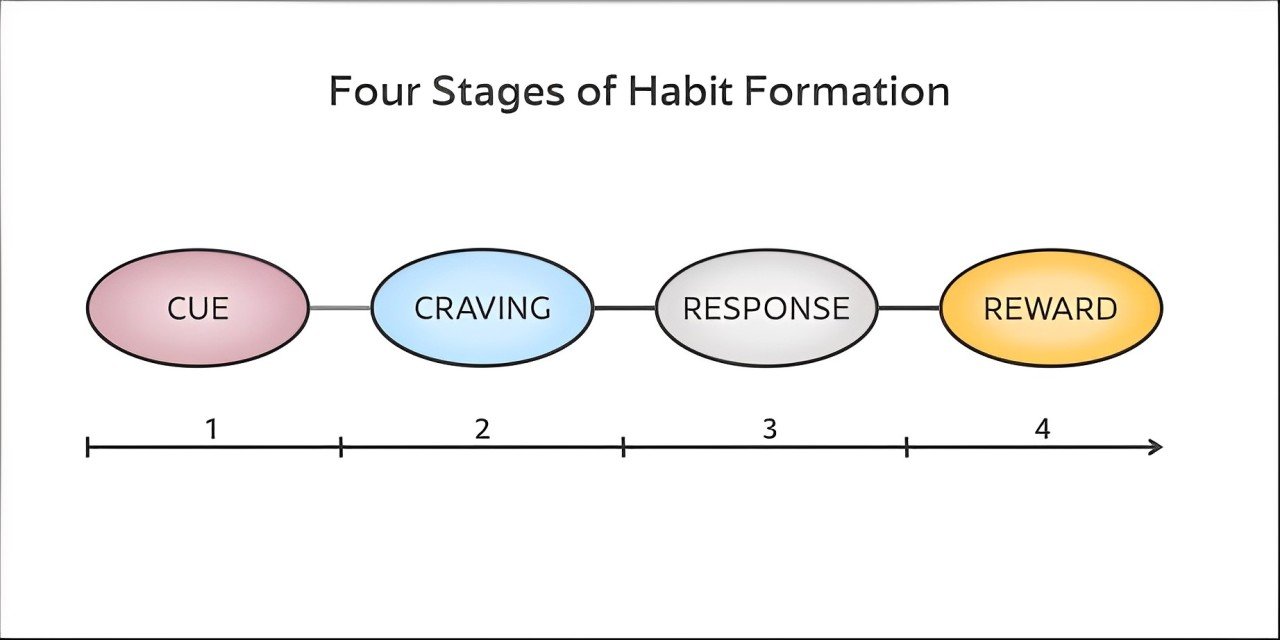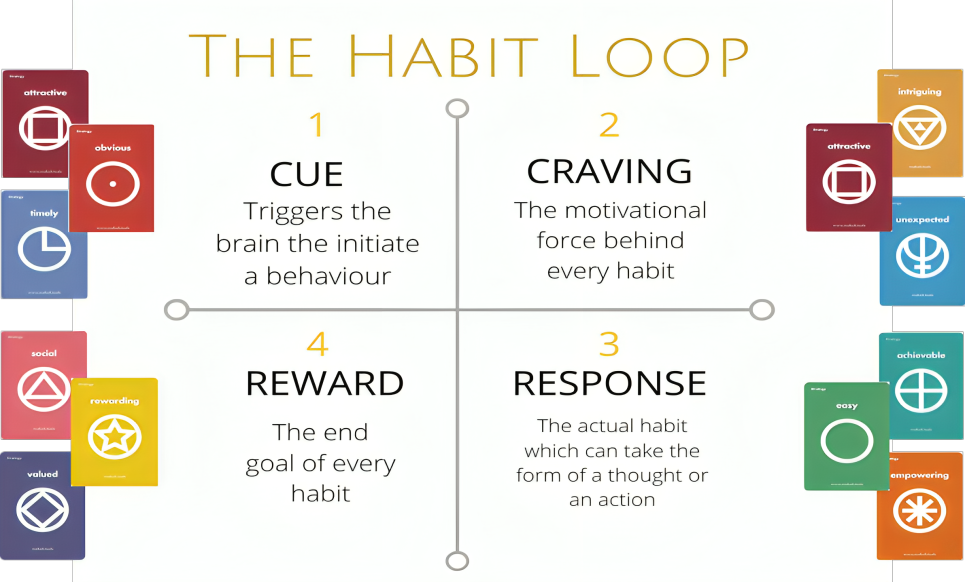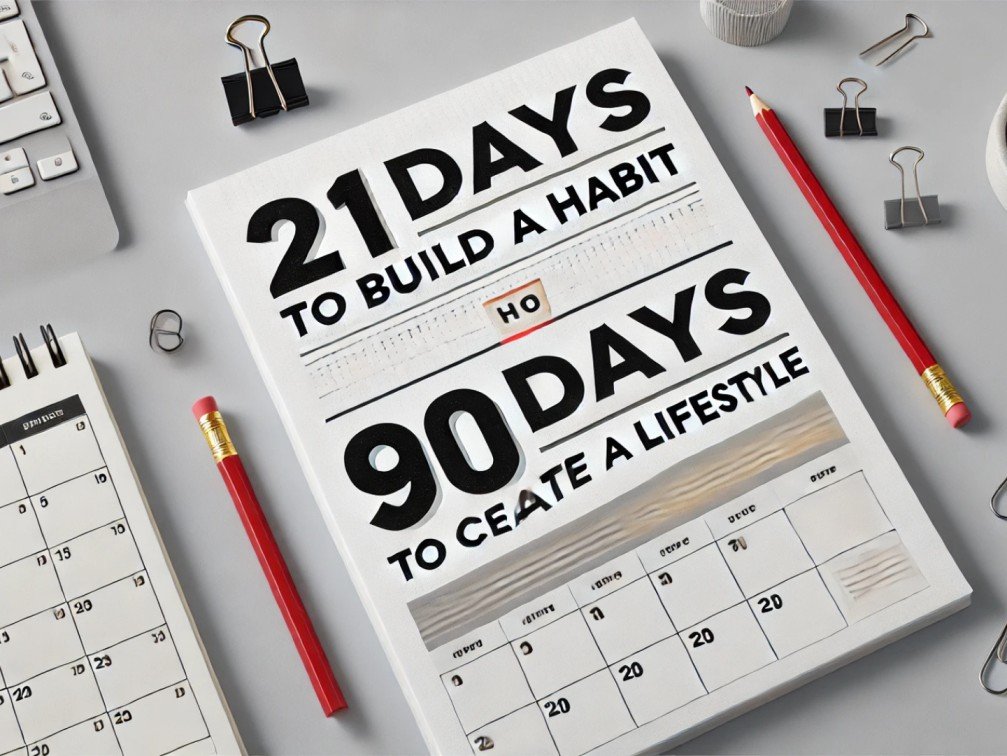The truth is we all have habits though probably some that are more or less obvious. Something as simple as making a cup of coffee in the morning or consuming social media content before going to bed are examples of such customs. However, if so, have you ever asked yourself, for instance, why something like, say, having turned into a habit takes no effort to maintain? In contrast, another one is almost impossible to practice day by day. The solution to the above question was in the science offering a new spin on forming habits. Learning it is a part of the process of habit formation that can help us create the best habits.

The Habit Loop: Cue, Craving, Response, and Reward
The habit infrastructure is known as the habit loop, a neurological cycle of behavior that underpins most human activities.
The habit loop is a cycle that one goes through as habits are created and which become automatic. It consists of four interconnected components: Cue, Craving, Response, and Reward.
The repertoire is initiated through the Cue, which is stimuli that prompt your brain to undertake a given course of action. This cue can be anything from a time of day to a specific location, or an emotionally produced state. For instance, the ringing of the alarm in the morning might be coded by your brain that it is morning and you need to get up whether it is to prepare coffee or awake to check on the phone. This cue leads to the rest of the pattern in the habit loop.
Following that is the cue that in translation means the Craving that underlies the aim of fulfilling a specific need or alleviating suffering. The desire is not for the conduct itself, but for anything that an individual gains out of practicing it, be it pleasure, achievement, or appreciation. For example, when you are drowsy in the afternoon, you will begin to crave something; perhaps coffee or food. The craving forms the habit loop and so makes you want to get a response to the behavior to satisfy the craving.
The third one is the Response which is the action taken to dutifully satisfy the craving by an individual. This could just be having a snack, taking a walk, looking at your phone, or even practicing meditation. The response is the most observable aspect of the habit loop and gets durably rewired the more often the loop is done. Each time you repeat this cycle your brain strengthens the association between the cue, the craving, and the response, making it easier with time to perform this habit. The response is important because it is the behavior that the brain will later on tend to encode.
Last, the Reward is the positive consequence that results from the behavior execution, which establishes the cycle. It can be physical (for example, getting a sense of refreshment after drinking water) emotional (such as relief felt after a meditation session), or mental (or a feeling of satisfaction after having done a given task). The reward helps to improve the connection between the cue and the behavior in the brain, which makes you likely to repeat the habit. In the habit loop, the cue clicks on the brain that a reward is on its way, and in due course, the process becomes automatic. That’s why it’s important to know how all of these aspects are interrelated; this knowledge will enable you to construct new actions or deconstruct extraneous ones deliberately.
The Way The Brain Creates Habits
The brain is very instrumental in making habits automatic. Human and animal motor habits are generated in the basal ganglia, a brain region that underlies emotions, memory, and pattern detection. I want to believe that habit forming is as simple as this, as soon as a habit is formed, this part of the brain takes over the task of repeating this behavior without requiring constant input from the other part of the brain.
The automation of this decision is important because it releases cognitive capacity for other activities. Still, it also contributes since the brain learns how to proceed and what stimuli to expect for achieving its goals and thus it is not easy to change bad habits. Your brain begins to look forward to it and will release dopamine, a happy chemical that makes you want to repeat a behavior. Sometimes, you’ll want to feel the reward before replying, which will be even more difficult to avoid over time.

The Path To Automaticity
The concept of the path to automaticity deals with the process by which activities are shifted from being highly conscious and effortful to being performed unconsciously and effortlessly. This change occurs through repeat and repetition; that is, making something a repeated pattern or stages of repeated changes. In other words, habit formation involves behaviors performed without prompting, repeated consistently – and therefore done consciously and on purpose – at least for the early stages. Eventually, when performed the same way often, it requires little effort because the brain rewires itself, which is called neuroplasticity.
The process of making a behavior automatic is said to last anywhere between 21 and 66 days, though for some behaviors it may take longer. Throughout early adulthood, Sox10 helps the brain ‘offload’ the behavior to the basal ganglia so that it can be performed more automatically. To achieve automaticity, one needs to be consistent and persistent in the implementation, for each process strengthens the association between the cue, behavior, and the reinforcer. When the process is habitual and natural, the behavior occurs without much thought or effort and takes a lot of mental energy, a task is done automatically. It reveals why it is possible to transform into powerful habits gradual and constant changes controlling the process.
Let us understand this with examples.
| Context | Cue | Behaviour/Response | Automatic Habit |
| Sitting at your work desk | Being at the desk at work | Opening your email | Checking email becomes a learned, automatic action |
| After dinner | Finishing a meal | Reaching for a candy bar | Eating a sweet treat becomes associated with meal completion |
| Morning routine | Waking up | Making a cup of coffee | Preparing coffee becomes a natural start to the day |
| Meeting deadlines | Feeling stressed about work | Procrastinating by watching videos | Procrastination becomes a habitual reaction to stress |
| Work break at noon | Noticing it’s lunchtime | Walking to get a snack | Getting a snack becomes part of the lunch break routine |
| Phone notifications | Phone buzzes with a new message | Checking your phone instantly | Checking the phone becomes an immediate reaction to notifications |
Influential Voices on Habit Formation
Masters from authors, psychologists, and other personalities have sought to explain who this influences and how habits define people’s lives. James Clear for instance in his book Atomic Habits has done outstanding work on simplifying how it is possible to get extraordinary results if a person only focuses on constantly improving small daily habits. In his New York Times bestseller, The Power of Habit, Charles Duhigg shows how the habit loop, cue, routine, and reward can help individuals regain control of their behaviors. Such luminaries as BJ Fogg, a psychologist, have also made some significant efforts to look at habits concerning the systematic design of improvements. These figures show that a habit is not just a unique personality trait, but a method that can be molded to become more effective in work, diet, and well-being. Their observations offer workable strategies for people who want to construct new or dismantle existing habits.
In Short
Consequently, habits are incredible tools that determine our everyday actions – they invisibly guide our lives. The habit loop works in four stages: cue, craving, response, and reward; once these stages are construed, the secrets to changing bad habits to good and developing new habits can be perceived. One way habit formation is efficient and effective is that the brain’s basal ganglia take on the automatic functions to save effort in one’s thinking. Experts like James Clear, Charles Duhigg, and BJ Fogg have insights into how habits work and stress on gradual continuous change. Habit is the autopilot of our lives because by perceiving the signals that compel us to act and consciously constructing our actions, we exercise a needless influence over our behaviors and thus can be adapted to create more efficiency, health, and happiness in our daily existence. Explaining the process of habit change is not only about the concept of habit being equal to a skill but also about being a process of learning; it is for the long term.
Stay tuned to inspire4ward for more updates.
FAQs
How long does it take to form a new habit?
While the commonly cited timeframe is 21 days, research suggests it can take anywhere from 18 to 254 days for a new habit to fully form, depending on the individual and the complexity of the habit.
What role do cues play in habit formation?
Cues serve as triggers for habits. They can be external (like time of day or environment) or internal (like emotions). Identifying and modifying cues can significantly impact habit formation.
What are some strategies to make habits stick?
Effective strategies include setting clear and specific goals, tracking progress, starting small, being consistent, and using positive reinforcement to celebrate milestones.
Why do some habits stick while others don’t?
Habits stick when tied to clear cues and meaningful rewards. Consistency and positive reinforcement, along with personal motivation, play critical roles in habit formation.
How can I break a bad habit?
Identify the cues that trigger the habit and the rewards it provides. Substitute the routine with a healthier behavior that satisfies the same reward. Awareness and support can also help.



